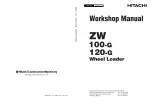
0-3
3. CONVERSION TABLE
3. CONVERSION TABLE
Method of using the Conversion Table
The Conversion Table in this section is provided to enable simple conversion of figures. For details of
the method of using the Conversion Table, see the example given below.
Example
Example
Method of using the Conversion Table to convert from millimeters to inches
Convert 55 mm into inches.
Locate the number 50 in the vertical column at the left side, take this as
ⓐ
, then draw a horizontal
line from
ⓐ
.
Locate the number 5in the row across the top, take this as
ⓑ
, then draw a perpendicular line
down from
ⓑ
.
Take the point where the two lines cross as
ⓒ
. This point
ⓒ
gives the value when converting
from millimeters to inches. Therefore, 55 mm = 2.165 inches.
Convert 550 mm into inches.
The number 550 does not appear in the table, so divide by 10 (move the decimal point one place
to the left) to convert it to 55 mm.
Carry out the same procedure as above to convert 55 mm to 2.165 inches.
The original value (550 mm) was divided by 10, so multiply 2.165 inches by 10 (move the decimal
point one place to the right) to return to the original value.
This gives 550 mm = 21.65 inches.
1.
2.
(1)
(2)
(3)
(1)
(2)
(3)
Millimeters to inches
Millimeters to inches
1mm = 0.03937 in
ⓑ
ⓐ
0 1 2 3 4 5 6 7 8 9
0
0.039 0.079 0.118 0.157 0.197 0.236 0.276 0.315 0.354
10 0.394 0.433 0.472 0.512 0.551 0.591 0.630 0.669 0.709 0.748
20 0.787 0.827 0.866 0.906 0.945 0.984 1.024 1.063 1.102 1.142
30 1.181 1.220 1.260 1.299 1.339 1.378 1.417 1.457 1.496 1.536
40 1.575 1.614 1.654 1.693 1.732 1.772 1.811 1.850 1.890 1.929
50 1.969 2.008 2.047 2.087 2.126 2.165 2.205 2.244 2.283 2.323
60 2.362 2.402 2.441 2.480 2.520 2.559 2.598 2.638 2.677 2.717
70 2.756 2.795 2.835 2.874 2.913 2.953 2.992 3.032 3.071 3.110
80 3.150 3.189 3.228 3.268 3.307 3.346 3.386 3.425 3.465 3.504
90 3.543 3.583 3.622 3.661 3.701 3.740 3.780 3.819 3.858 3.898
ⓒ
Summary of Contents for HL955
Page 557: ...7 6 MEMORANDUM MEMORANDUM ...





























